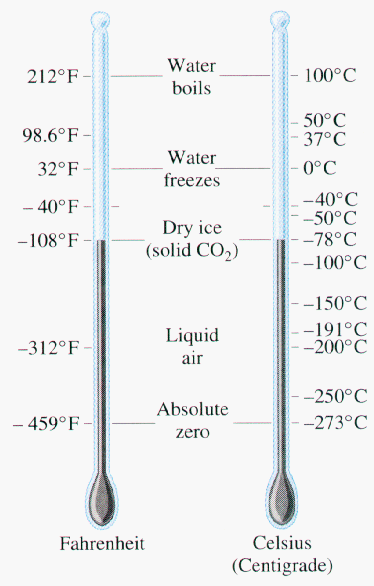Convert from Fahrenheit to Celsius and back
What is Fahrenheit?
It is a temperature scale, or a number system assigned to temperature in order to track/record differences in temperature.
The scale is named after it's inventor, Daniel Gabriel Fahrenheit, who was a German physicist and engineer.
Born May 24, 1686 Fahrenheit spent most of his life in the Dutch Republic where his family had moved. Fahrenheit was born into a merchant family, but was interested in natural sciences not trade. When his parents died from the consumption of poisonous mushrooms (I'm not making this up folks), Daniel was forced by the circumstances to move to Russia and take up trade to survive.
In 1717 he settled in The Hague and took up glassblowing. In that time he made barometers, altimeters, and thermometers. Though Fahrenheit did not invent the thermometer he was the first to use mercury and the first to make thermometers that were so accurate that two or more of his thermometers showed the exact same temperature.
The Scale: Fahrenheit determined that certain 'benchmarks' in temperature should be used to determine the scale. Those 'benchmarks' were absolute* zero, the temperature at which water froze, the normal temperature of the human body, and the boiling point of water.
Of course this was a new science, but eventually the scale benchmarks were set at 0, 32, 100, and (later) 212 degrees. This last, the boiling point of water, could only be measured with mercury thermometers.
* In this case the coldest temperature that could be attained at that time.
What is Celsius?
Celsius is named for a Swedish astronomer Anders Celsius. Anders developed this temperature scale two years before his death. In Anders' original scale zero was boiling point and one hundred the temperature at which water froze. In 1744, when Anders Celsius died, Carl Linnaeus, a Swedish Botanist, reversed the scale to it's present form.
As with Fahrenheit, Celsius was to be based on two naturally occurring temperature events. Chosen were the freezing and boiling points of water. For this reason 0° is the melting point of ice and 100° the boiling point of water.
Graphic Scales

Converting C° to F° or F° to C°
To convert from Celsius to Fahrenheit use the following formula.
F° = C° × 9 ⁄ 5 + 32
So in this example if the temperature in C° is 30 you determine the Fahrenheit temperature by multiplying 30 by 9 which gives you 270. Then divide 270 by 5 which gives you 54 and finally add 32 to the 54 to get 86 degrees Fahrenheit.
You could also use the decimal value, which in this case would be determined by dividing 9 by 5 which results in 1.8. Using this in a formula 37 degrees would look like this;
F° = 37° X 1.8 + 32
37 times 1.8 equals 66.6. plus 32 equals 98.6.
To get Celsius from Fahrenheit use the following formula
F° - 32 × 5 ⁄ 9 = C°
So in this example, using the "standard" human temperature of 98.6°, first subtract 32 from 98.6 which gives you 66.6. Multiply 66.6 by 5 which gives you 333 and finally divide 333 by 9 which gives you 37.
Another way to do this is to determine the decimal equivalent to 5 divided by 9 which is 0.555556 (roughly). Using the decimal for 5 divided by 9 the formula then becomes;
C° = F° - 32 X 0.555556
Or 98.6 - 32 equals 66.6 times 0.555556 equals 37.00002.








